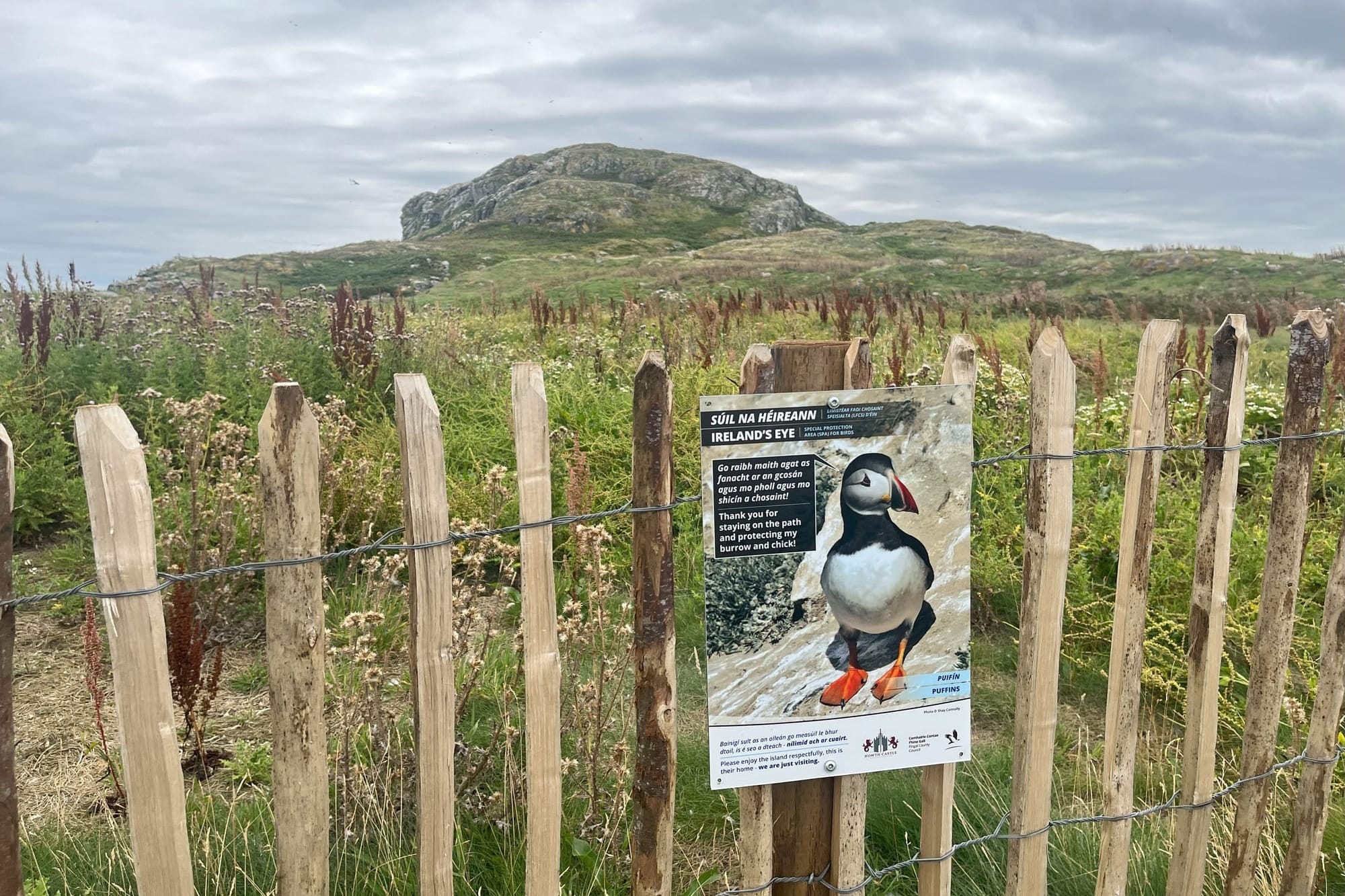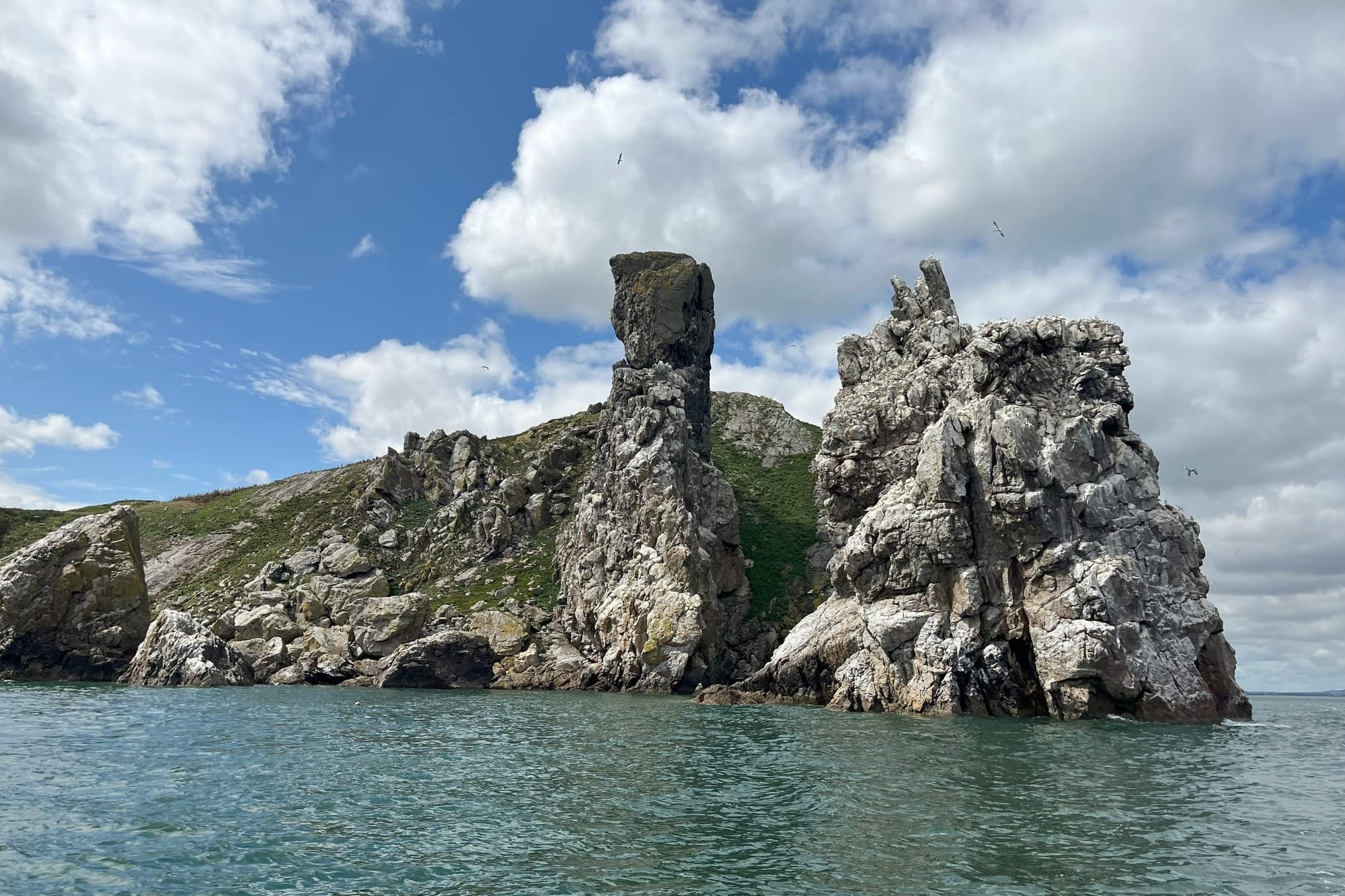As an anti-immigrant encampment dwindles on Basin View, its organisers try to rally
One man who’s been involved has been trying to organise a social event on a nearby council football pitch, something the council says it’s “monitoring”.
The island off Howth is a haven for puffins, cormorants, and more. But human visitors have continued to stress them.

On Monday afternoon around 2pm, Canadian tourists Mackenzie Crockett and Delaney Heeney were sunbathing on a beach on Ireland’s Eye.
Crockett said they learned about the little island off Howth through TikTok, and then later a tour guide recommended visiting it.
So they decided to spend their last day in Ireland here, and got on one of the small boats that periodically motor out about 1km from Howth Harbour to the island.
“The puffins were kind of what got us to come here,” Crockett said. “The beach is a very nice bonus.”
They and other tourists have congregated on this south-facing beach. It’s sandy, with colourful fist-sized stones, pools of purple and iridescent spiral shells.
Some are pulling out picnics and swimming trunks. Rory Carmody is chaperoning a dozen-odd 12- to 13-year-old boys, racing in and out of the water, part of Belvedere Youth Club.
They too had been hoping to see puffins, Carmody says. But no luck. “No puffins or anything like that,” he says.
This is no accident. Most of the island’s rare birds congregate on the opposite side of the island from where the small number of visiting tourists have gathered.
This is due to the birds’ own shyness, and also efforts by the island’s managers to keep people away from the birds.
Foot traffic threatens the birds’ habitat, to the point where there was talk last year of closing off Ireland’s Eye to visitors, to protect the wildlife, says Eoin Quinlan, general manager of Howth Castle Estate, which includes the island.
But instead, Tetrarch Capital-owned Howth Castle Estate teamed up with Fingal County Council, with some input from the National Parks and Wildlife Service to try alternative ways to tackle the problem.
This summer they added in new fencing, new signage, and two pilot wardens who warn visitors, please, keep off bird territory.
Ireland’s Eye is a special place for birds, says Fingal County Council biodiversity officer Lorraine Bull.
“So it's one of the, kind of, rarer locations where there's different types of birds that are nesting,” Bull said by phone last Wednesday.
That includes a long list of sea birds: guillemots, razorbills, kittiwakes, cormorants, and gulls.
“But then you also have, on top of that, internationally important numbers of gannet, fulmar, shag,” Bull said. “And then also puffins.”
Island visitors often unintentionally cause problems for the birds, Bull says.
"The birds are busy trying to feed and raise their young,” she said. When people come near their nests, it’s extremely stressful for them.
Some nests and eggs are hidden from sight, to keep them safe, Bull said. But it means humans can be oblivious to what they’re trampling on.
And humans can also be oblivious to birds' attempts to communicate too, Bull says. For example, if a bird or multiple birds are squawking, that means: go away.
But there can be other cues too, she says. “In some of the seabirds, they will open their mouths, they'll have, like, a gaping – and that's you're getting too close.”
“It’s not always that when you’re disturbing a bird, they fly away,” she said. “Generally, a bird, especially a nesting bird, will only leave its nest when it actually thinks it's actually under, you know, severe, you know, threat.”

When they installed new signs to try to keep tourists away from the nesting areas of all these birds, they took a different approach – make the new signage friendly, Bull said.
“Traditional signage in locations would be: ‘Don't do this, don't do that,’” she said. This time, the approach is to try to inform visitors about the birds – ask them to help.
The signs tell people there’s birds nesting in the area, and ask them to please keep on the path, and thank them for their help, Bull says. “If you thank people … ,” she says, “You can sometimes get a better response.”
Within a couple of weeks of the signs going up the wardens noticed a difference, Bull says.
“The first couple of weekends we were still installing the signage, about only 50 percent of people may be stuck to the path,” she says. “But then by the time everything went in, it was about 80 percent.”
Still, though, there’s some people who don’t help protect the birds, says Quinlan, the general manager of the Howth Castle Estate.
On the beach, he pointed at a few Heineken bottles in the crevice of a big rock. There was a shopping basket with vodka bottles, and more beer bottles.
Those had been left by people who’d come over to the island on jetskis, against the rules. He saw them, two weekends ago, from the castle across the harbour, Quinlan said.
“I counted 18 tents, three bonfires, five dogs,” he said. “So very, very problematic, very problematic. They are playing music at night.”
He said they probably didn’t get it. This kind of disturbance, it will scare away birds, they might not nest there next year. It’s not harmless fun, Quinlan says.
“They would light their fire. They'd put a tent up there, and they'd have no idea that quite an important species of bird is nesting just there,” he said.

Quinlan, manager of the Howth Castle Estate, doesn’t want to close off the picturesque island to visitors.
“The greatest shame that could happen, is that we are no longer able to bring the public out here,” he says.
But Quinlan said it’s about balance: managing numbers of visitors, and their behaviour.
“It's a balance between people being able to view the island, take it all in, see birds nesting, see the wildlife, but not destroy us."
On Monday, Quinlan walked through shoulder-sized ferns, towards the jagged-cliffed ends stacked with black guillemot, some circling the sea in search of fish.
He was watching, looking for the puffins too. But gently, not in a hurry.
As he made his way around the island, he paid attention to their cues.
The oystercatchers started squawking, near the area where Quinland thought the puffins would probably be.
So he backed off.
Funded by the Local Democracy Reporting Scheme.